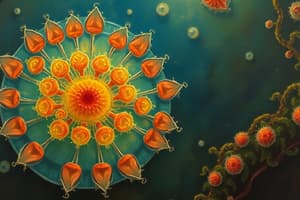Podcast
Questions and Answers
What phylum is Staphylococcus aureus a member of?
What phylum is Staphylococcus aureus a member of?
- Basidiomycota
- Ascomycota
- Eubacteria (correct)
- Zygomycota
What are the fundamental structural differences between the general types of asexual spores?
What are the fundamental structural differences between the general types of asexual spores?
Conidiospores: Free spores not enclosed in a sac; Sporangiospores: Successive cleavages in a sac-like head.
Bacteria like E. coli and MRSA are members of the ______ domain.
Bacteria like E. coli and MRSA are members of the ______ domain.
Bacteria/Eubacteria
Gram-positive cells will still be purple if the alcohol step is left out.
Gram-positive cells will still be purple if the alcohol step is left out.
What disease does Trypanosoma cruzi cause?
What disease does Trypanosoma cruzi cause?
Which microbes are classified as eukaryotes?
Which microbes are classified as eukaryotes?
Match the following sizes to their categories:
Match the following sizes to their categories:
What are the common characteristics that all cells have?
What are the common characteristics that all cells have?
Study Notes
Microorganisms and Their Characteristics
- Staphylococcus aureus belongs to the phylum Firmicutes.
- Bacteria can be classified by size: approximately 1-10 micrometers (µm) for microscopic organisms, and macroscopic organisms range from 10-100 micrometers (µm).
- E.coli and MRSA are in the domain Bacteria/Eubacteria.
Fungal Asexual Spores
- Two types of fungal asexual spores are conidiospores (not enclosed in a sac) and sporangiospores (formed inside a sac-like structure called a sporangium).
- Phylum Zygomycota produces zygospores as sexual spores and sporangiospores as asexual spores, with Rhizopus being a notable example.
Scientific Naming
- Scientific names follow binomial nomenclature: capitalize the genus name, italicize or underline the complete name, with the species name in lowercase.
Gram Staining and Cell Characteristics
- If the alcohol step is omitted in Gram staining, Gram-positive cells remain purple.
- Common characteristics of all cells include ribosomes, cell membrane, and DNA.
Eukaryotes vs. Prokaryotes
- Eukaryotic microorganisms include fungi, protozoa, algae, and helminths.
- Prokaryotic microorganisms are classified as bacteria or eubacteria, as well as archaea.
- Viruses do not fit into prokaryotic or eukaryotic classifications.
Microbial Benefits
- Microorganisms contribute to the environment by producing oxygen and sugar, recycling nutrients, and forming soil and greenhouse gases.
Disease Associations
- Trypanosoma cruzi is the causative agent of Chagas disease.
Size Ranges
- General size range for macroscopic organisms is from centimeters (cm) to meters (m).
- Microscopic organisms typically fall within the range of nanometers (nm) to millimeters (mm).
Studying That Suits You
Use AI to generate personalized quizzes and flashcards to suit your learning preferences.
Description
Prepare for your Microbiology Lecture 1 Exam with these review questions designed to solidify your understanding of key concepts. This set of flashcards covers essential topics that are relevant for your upcoming exam, helping you to study effectively and efficiently.



